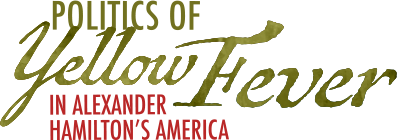Class 2: Politics and Medicine Collide During the Yellow Fever Epidemic
Introduction:
Building on the discussion in Class 1, this session explores how politicians and partisans politicized the debate about the origin, transmission, and treatment of yellow fever. The disagreement between Dr. Benjamin Rush, a prominent physician and republican, and Secretary of the Treasury Alexander Hamilton, the leader of the Federalist party, serves as a case study for the class discussion. At the close of the class, students are encouraged to find contemporary examples in which politics and public health have intersected and extend the insights from the readings to these examples.
Class Resources
Readings
Secondary Sources
Secondary Sources
- Apel, Thomas A. Feverish Bodies, Enlightened Minds: Science and the Yellow Fever Controversy in the Early American Republic. Stanford, CA: Stanford University Press, 2016. pp. 117–143
- Pernick, Martin S. “Politics, Parties, and Pestilence: Epidemic Yellow Fever in Philadelphia and the Rise of the First Party System.” The William and Mary Quarterly 29, no. 4 (October 1, 1972): 559–86.
- Bureau of Engraving and Printing. Alexander Hamilton. n.d. Engraving.
- Congressional Pugilists. 1798. Etching on woven paper. Library of Congress, Prints and Photographs Division.
- Hamilton, Alexander. “Letter from Alexander Hamilton to the Federal Gazette.” Gazette of the United States. September 14, 1793. Courtesy Library of Congress – Chronicling America.
- Rush, Benjamin. An Account of the Bilious Remitting Yellow Fever, as It Appeared in the City of Philadelphia, in the Year 1793. 2nd ed. Philadelphia, PA: Thomas Dobson, 1794. pp. 298-314 and 325-330. From U.S. National Library of Medicine: Digital Collections. http://resource.nlm.nih.gov/101283166
Discussion Questions
- During the Early Republic, the boundaries between science, politics, physical health, and spiritual well-being were often blurred. Why?
- During the 1790s, both federalism and republicanism appeared well-aligned with divergent, longstanding explanations for yellow fever’s origin and transmission. Using examples drawn from Pernick and Apel, identify which explanations appealed to Federalists and which explanations of yellow fever appealed to republicans and why.
- According to Apel and Pernick, how did yellow fever become a political debate rather than a medical debate? What was at stake for each political faction?
- How might Hamilton’s letter, published in the Gazette of the United States, be understood as political? What, if any, political motive might he have for such a stance?
- Apel (pp. 128–129) explains that “discourses about politics and science shared structural similarities and took place in the same public spaces. In both, discursive communities—factions—formed through networks of personal correspondence and private associations, and they communicated through newspapers, pamphlet wars, and even public oratory.” What does Apel mean here? How does this change your reading of newspaper articles by the likes of Hamilton and Rush?
- What purpose did it serve for Rush to dismiss Hamilton’s bout with yellow fever (see Rush pp. 304–305)?
- Why does Rush want to “take the cure of pestilential fevers out of the hands of physicians, and to place it in the hands of the people?” (p. 325) How does this align with his political ideology?
- Look at the political cartoon, Congressional Pugilists, published just five years after yellow fever decimated Philadelphia. What does it say about the state of partisanship in 1798?
- What are some contemporary examples of political ideology shaping response to a disease or epidemic? How do you see politics influencing disease response today?






